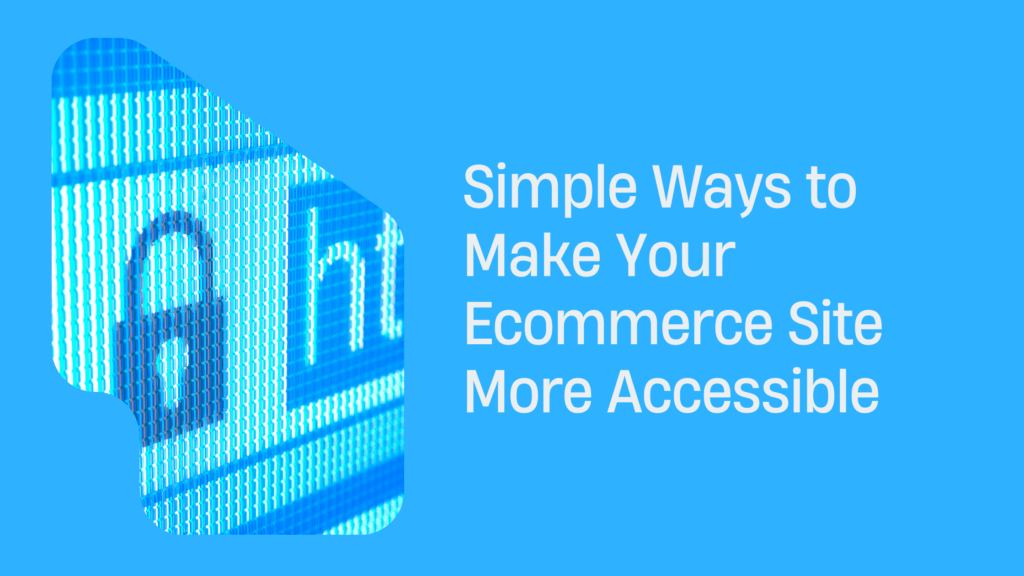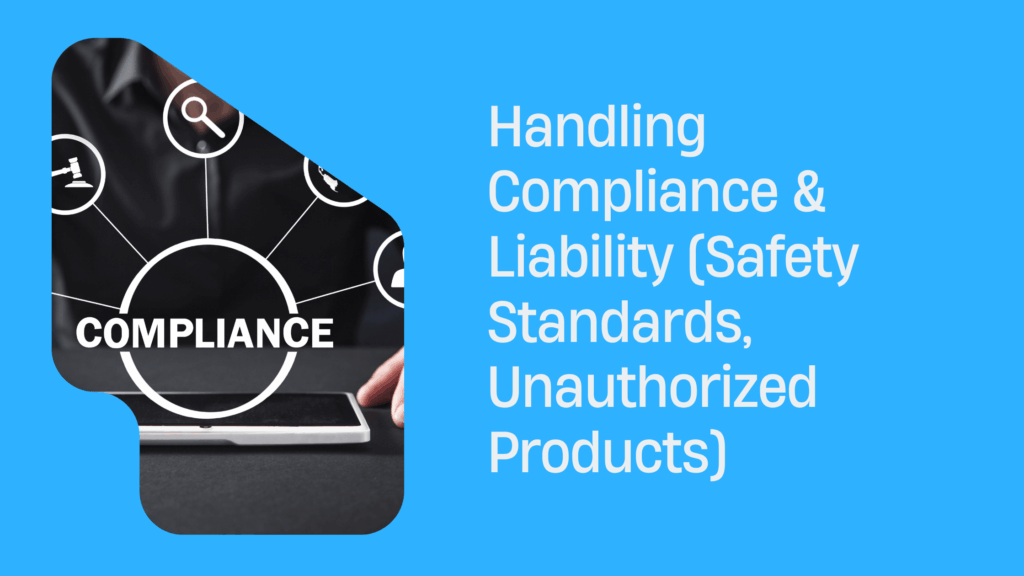Simple Ways to Make Your Ecommerce Site More Accessible
Website accessibility in ecommerce refers to designing online stores so all users, including those with visual, auditory, motor, or cognitive disabilities, can browse and complete purchases without barriers.
It ensures equal access to products, information, and services, regardless of individual limitations. Accessible websites also support smoother interactions for users on different devices and network conditions.
This blog explains practical, non-technical methods that merchants can apply to improve usability. The focus is on simple adjustments, such as design enhancements, clear navigation, descriptive text elements, and checkout improvements, that make e-commerce sites more inclusive, user-friendly, and effective in reaching wider audiences.
Why Accessibility Matters for Ecommerce
Accessibility in ecommerce ensures equal usability for all customers. It improves experiences for people with disabilities, widens audience reach, strengthens brand reputation, and supports compliance with search and web standards.
Enhancing Customer Experience and Inclusivity
Accessible design improves usability for all customers, including those with visual, auditory, or mobility limitations. Clear navigation, readable fonts, and alt text ensure products are discoverable and understandable. Screen-reader compatibility supports customers who rely on assistive technologies, while simplified checkout processes reduce barriers.
By removing obstacles, accessibility creates a more inclusive shopping environment where all users can browse and purchase confidently. This results in higher satisfaction, reduced frustration, and stronger engagement across diverse audiences, supporting a seamless and equitable customer journey.
Expanding Potential Customer Base
- Inclusive Access – Designing for accessibility opens the store to customers with disabilities who may otherwise face barriers.
- Cross-Device Usability – Accessible features ensure consistent performance across mobile devices, tablets, and assistive technologies, attracting a diverse audience.
- Global Reach – Multilingual alt text, captions, and readable design elements support diverse demographics worldwide.
- Broader Engagement – Accessibility fosters loyalty from customers who value inclusivity, encouraging repeat visits and referrals.
Positive Influence on Brand Reputation and Trust
- Perception of Responsibility – Demonstrating accessibility reflects a commitment to inclusivity and ethical business practices.
- Customer Loyalty – Users value brands that prioritize accessibility, fostering long-term trust and repeat purchases.
- Word-of-Mouth Advocacy – Positive experiences from accessible design encourage customers to share and recommend the brand.
- Competitive Differentiation – Accessibility positions a store as forward-thinking, setting it apart from competitors who neglect usability.
Contribution to Search Engine Optimization and Compliance with Web Standards
- Improved Indexing – Alt text and descriptive tags make content easier for search engines to crawl and index.
- Higher Rankings – Accessible design improves site performance, mobile usability, and structured content, all of which enhance SEO.
- Better User Metrics – Lower bounce rates and longer session times from accessible navigation signal search engines of higher quality.
- Regulatory Alignment – Compliance with WCAG (Web Content Accessibility Guidelines) and related standards reduces legal risks.
- Sustainable Growth – Combining SEO benefits with compliance ensures long-term visibility and trust with both users and regulators.
Practical Design Adjustments for Better Accessibility
Design adjustments improve accessibility by making websites easier to read and navigate for all users. Small visual changes ensure inclusivity, reduce friction, and create a more user-friendly ecommerce experience.
- Use Legible Font Sizes – Ensure body text is no smaller than 16px for readability. Allow users to resize text without breaking layout or functionality. Avoid overly decorative fonts.
- Maintain High Color Contrast – Provide sufficient contrast between text and background. Follow WCAG standards of at least 4.5:1 for normal text. Use tools to test contrast across different devices.
- Avoid Color-Only Indicators – Do not rely solely on color to convey meaning, such as marking errors in red. Use symbols, patterns, or descriptive text to support color cues.
- Provide Scalable Text – Ensure font sizes adapt across screen resolutions and devices. Use relative units like “em” or percentages instead of fixed pixels for scalable typography.
- Consistent Heading Structures – Apply hierarchical headings (H1, H2, H3) to break content into sections. This improves readability and helps screen readers interpret page structure accurately.
- Readable Line Spacing and Alignment – Maintain sufficient spacing between lines and paragraphs to reduce strain. Avoid full-justified text as it can create uneven spacing and hinder readability.
- Accessible Visual Cues – Use clear icons, labels, and shapes that remain identifiable without color. Provide tooltips or alternative descriptions for symbols where necessary.
- Support for Dark Mode – Ensure your design remains readable in dark mode by maintaining proper contrast and avoiding color clashes that reduce legibility.
Alternative Content Formats
- Descriptive Alt Text for Images – Every image should include alternative text that describes its purpose or content. Alt text enables screen readers to convey visual information to users with visual impairments. Descriptions must be concise, accurate, and context-specific.
- Captions for Videos – Adding captions to videos ensures accessibility for users with hearing impairments. Captions should be synchronized with audio, accurate in meaning, and easy to read. Using a video caption generator makes this process more efficient by automating caption creation. Closed captioning options provide additional flexibility for viewers.
- Text Transcripts for Multimedia – Audio and video content should have accompanying text transcripts. Transcripts allow users who cannot access sound or visuals to understand the message. They also improve search engine indexing by making multimedia content readable.
- Accessible Icons and Graphics – Icons or graphical symbols should have text labels or tooltips explaining their function. Without descriptions, users relying on assistive technologies may not understand the purpose of these elements. Clear labels ensure consistent usability.
- Avoiding Text in Images – Text embedded inside images is not accessible to screen readers. Important information, such as product details or promotions, should always be provided as real text in HTML. This ensures scalability and accessibility across devices.
- Providing Downloadable Formats – Complex documents or guides should be available in multiple accessible formats, such as HTML or tagged PDF. These formats are easier for assistive technologies to interpret and allow users to choose the most suitable option.
Improving Navigation and Checkout Usability
Clear navigation and streamlined checkout are essential for accessibility. Simple structures, screen-reader compatibility, and consistent layouts ensure all users, including those with disabilities, can complete purchases without barriers.
Designing Logical Menu Structures with Clear Headings
- Organize Menus by Hierarchy – Group related categories under clear parent sections and use submenus only when necessary. Keep the structure shallow to minimize clicks and help users reach content quickly.
- Use Descriptive Headings – Label each section with precise terms that reflect the content. Avoid vague language like “More” or “Stuff.” Descriptive headings improve scanning, assist screen readers, and guide users effectively.
Enabling Full Keyboard Navigation
- Support Tab Navigation – Ensure users can move through menus, forms, and checkout fields using the Tab key without skipping critical elements.
- Highlight Focus States – Provide visible outlines or highlights when elements are selected to guide users relying on keyboards.
- Allow Shortcut Access – Implement keyboard shortcuts for key actions, such as returning to the homepage or opening the cart.
- Ensure Form Completion – Confirm all form fields, buttons, and dropdowns are fully accessible without requiring a mouse.
Making Navigation and Checkout Processes Compatible with Screen Readers
Screen-reader compatibility requires structured HTML with semantic elements such as headings, lists, and landmarks. Labels must be linked to form fields, and button functions should be clearly defined. Checkout instructions must be concise and announced correctly by assistive technologies.
Alternative text for icons and clear error messages ensure accuracy during form submission. Consistent use of aria-labels and descriptive attributes helps screen readers interpret menus and checkout steps, enabling visually impaired users to complete purchases independently and without confusion.
Using Consistent Layout Patterns to Reduce Cognitive Load
- Maintain Uniform Page Layouts – Use similar structures across product, category, and checkout pages to minimize user disorientation.
- Keep Navigation Placement Fixed – Place menus, search bars, and carts in consistent positions across all pages.
- Standardize Button Styles – Apply the same color, shape, and labeling to key actions like “Add to Cart” and “Checkout.”
- Simplify Information Flow – Present essential steps in predictable sequences without unnecessary diversions.
- Limit Design Variations – Avoid frequent visual or structural changes that force users to relearn navigation on each page.
Writing Clear and Descriptive Text Elements
Clear text elements improve usability by guiding users accurately across the site. Descriptive link text ensures clarity for all visitors, including those relying on screen readers for navigation.
Link Text
- Use Meaningful Phrases – Links should describe the destination or action clearly. For example, “View shipping details” is more informative than “Click here.” Meaningful text helps users anticipate outcomes.
- Avoid Generic Terms – Phrases like “Read more” or “Learn more” provide little context. When necessary, pair them with descriptive keywords, such as “Read more about payment options,” to improve accessibility.
- Ensure Contextual Clarity – Links must make sense even when read outside the surrounding text. Screen readers often list links separately, so self-contained clarity is essential for usability.
- Keep Text Concise – Link text should be brief but informative. Avoid long sentences or unnecessary words. This maintains readability and ensures a smoother user experience across devices.
- Differentiate from Surrounding Text – Links must be visually distinct using underlines, bold formatting, or consistent color contrasts. Do not rely on color alone, as it can exclude color-blind users.
- Avoid Redundancy – Do not repeat the same link text for different destinations. Each link should be unique to avoid confusion and ensure accurate navigation for assistive technologies.
- Match User Intent – Links should reflect the action users expect. For example, a link labeled “Download invoice” must lead directly to the file, not to a general information page.
- Test with Assistive Tools – Review link behavior using screen readers and accessibility checkers to confirm clarity, functionality, and usability across different accessibility needs.
Form Labels
Form labels play a critical role in ensuring ecommerce sites are accessible and user-friendly. Clear labeling improves usability for all customers, including those using assistive technologies. The following points outline best practices for effective form labels:
Direct Association with Fields
- Each input field should have a linked label.
- Screen readers rely on this connection to announce the purpose of the field.
- Use HTML <label> elements instead of placeholder text alone.
Clarity and Simplicity
- Labels must use straightforward language.
- Avoid jargon or abbreviations that could confuse users.
- Example: “Email Address” is clearer than “Enter ID.”
Visibility Over Placeholders
- Labels should remain visible even when the field is active.
- Placeholder text disappears when typing, which can confuse users.
- Persistent labels reduce errors and improve accessibility.
Instructions and Field Requirements
- Indicate mandatory fields with text or symbols, but avoid using color alone.
- Provide short instructions for accepted formats, such as date or phone number styles.
- This prevents unnecessary submission errors.
Error Feedback Integration
- Labels should be linked to error messages when validation fails.
- Error text must clearly explain what went wrong and how to fix it.
- For example: “Password must be at least 8 characters, including one number.”
Consistent Placement
- Position labels close to their input fields.
- Consistency across the site improves scanning and form completion speed.
Testing and Maintaining Accessibility Standards
Regular testing and maintenance are essential to ensure accessibility remains consistent across your ecommerce site. Structured evaluation, user input, and ongoing monitoring help sustain usability for all customers over time.
- Use Automated Accessibility Tools – Employ free and paid tools such as WAVE, AXE, or Lighthouse to scan your site for issues. These tools quickly identify missing alt text, poor color contrast, or incorrect heading structures.
- Conduct Manual Audits – Automated tools cannot detect all accessibility barriers. Regular manual checks ensure menus, forms, and checkout flows remain fully navigable with a keyboard and screen reader. This prevents overlooked usability problems.
- Test Across Multiple Devices and Browsers – Accessibility must function consistently on desktops, tablets, and mobile devices. Test your site on various browsers and operating systems to confirm design elements, navigation, and content remain accessible.
- Engage Real Users for Feedback – Collect input from individuals with diverse accessibility needs, such as screen reader users. Real-world feedback helps uncover practical challenges that automated or manual checks may not reveal.
- Monitor Content Updates – Each time new products, images, or features are added, review accessibility elements like alt text, link descriptions, and form labels. Consistent updates ensure compliance remains intact as the site grows.
- Establish Accessibility Guidelines for Teams – Create internal documentation on accessibility best practices for content creators, designers, and developers. Standardized processes reduce errors and maintain consistency across all digital assets.
- Schedule Periodic Reviews – Set quarterly or biannual accessibility reviews. Regular audits prevent small issues from accumulating and ensure the site stays aligned with evolving standards such as WCAG updates.
- Track Metrics for Continuous Improvement – Monitor accessibility performance indicators, such as bounce rates or abandoned checkouts from assistive users. Data-driven insights help refine accessibility measures and maintain a seamless shopping experience.
Long-Term Benefits of Accessibility
Accessibility delivers sustained value by improving usability, strengthening brand reputation, and enhancing search performance. It ensures inclusive experiences that benefit customers while supporting business growth and compliance with evolving digital standards.
Expanded Customer Reach
- Accessible design ensures that customers with visual, auditory, motor, or cognitive disabilities can use the site without barriers.
- This widens the audience base and creates opportunities for increased sales.
Improved User Experience
- Accessibility features like clear navigation, descriptive links, and readable fonts improve usability for all customers, not only those with disabilities.
- Enhanced usability reduces friction during browsing and checkout, encouraging repeat visits.
Strengthened Brand Reputation
- Demonstrating commitment to accessibility builds trust and positions the brand as socially responsible.
- Customers are more likely to engage with businesses that prioritize inclusivity and transparency.
Higher Search Engine Visibility
- Features such as alt text, descriptive headings, and structured content improve search engine optimization.
- Search engines reward accessible websites with better indexing, improving rankings, and organic traffic.
Compliance with Digital Standards
- Accessibility practices align with guidelines such as the Web Content Accessibility Guidelines (WCAG).
- Meeting these standards reduces the risk of legal issues and ensures readiness for future regulatory changes.
Reduced Bounce Rates and Higher Conversions
- By removing barriers, users are less likely to abandon the site due to difficulty navigating or reading content.
- Clear forms, error messages, and checkout processes help increase completed transactions.
Future-Proofing the Business
- An accessible site adapts better to new devices, voice search technologies, and assistive tools.
- This ensures long-term scalability and relevance in a changing digital landscape.
Conclusion
Simple design changes such as larger fonts, high-contrast colors, and descriptive alt text improve usability for all visitors. Clear navigation, screen-reader compatibility, and structured checkout flows ensure smoother access across devices. Descriptive link text and accurate form labels further reduce barriers and improve clarity.
Regular testing and updates help maintain consistent accessibility standards as new content is added. Accessibility should be viewed as a long-term practice that enhances user experience and inclusivity. By prioritizing accessible design and communication, ecommerce sites can expand reach, strengthen trust, and create an environment where every customer can interact with equal ease.



